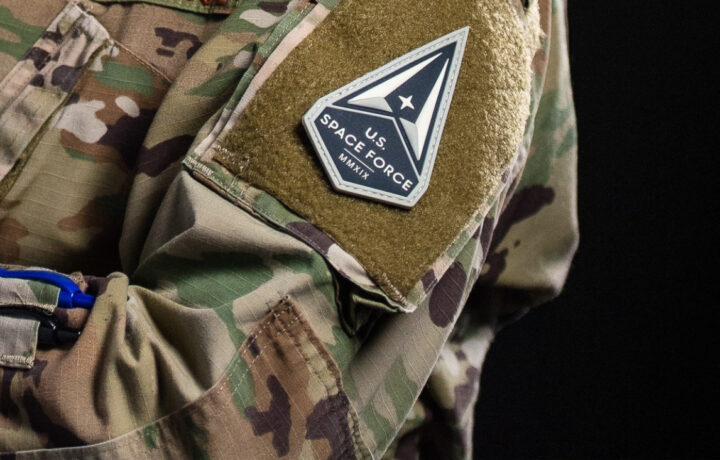The United States Space Force has been working with the Institute of Heraldry at Fort Belvoir, VA to design and create insignia for seals, badges, chevrons, and other uniform accessories to differentiate the branch from the rest of the force.
In what is fitting for the service, it is a true 21st-century twist on what has been a standard part of American military uniforms for more than a century.
Origins of Military Patches and Insignia
United States military shoulder patches can be traced back to the American Civil War – when field uniforms became more “uniform” in design. Prior to that point, military units were largely identified by the type of uniform, piping, and other insignia, but as the U.S. Army swelled in size, the uniforms became far more standardized. However, attempts were still made for units and even individual soldiers to stand out.
Initially, this consisted of embroidered patches that were typically made by mothers, wives, and girlfriends – and generally, while these weren’t authorized, there were few complaints by commanders. It was also during the Civil War that Confederate forces, which had less formal uniforms, needed some way to identify the unit that individual troops served in.
American soldiers on both sides began to follow a practice that had been common in the British Army for more than a century – to use specific patches that identified a unit. Originally these were only worn by high-ranking British officers, but eventually, soldiers of all ranks wore cap badges or dress helmet plates that could make it easy to identify a particular unit. During the First World War, when the British adopted steel helmets, the unit insignia was painted on the side or front. Later shoulder insignia was adopted, which more easily identified the unit.
Evolution of the American Military Shoulder Insignia
When the United States entered the war in 1917, the Army’s 81st Infantry Division adopted the practice of unit shoulder patches. Its shoulder insignia featured elements that reportedly had a meaning to the unit, which trained at Fort Jackson, South Carolina. Because the troops had trained near a body of water known as Wildcat Creek, the patch featured a wildcat on an olive-drab background.
The “Wildcat” Division’s unit patch was brought to the attention of the commander of the American Expeditionary Force, General John J. “Blackjack” Pershing. The officer who reported it to Pershing thought the patch was “unbecoming of the uniform,” but Pershing – the only American to be promoted General of the Armies in his lifetime – felt otherwise and decided the 81st should keep the insignia.
Other units soon adopted their own patches. And this was eventually adopted by every Army group, squad, corps, and division. Patches became the norm, and the designs became increasingly more creative and intricate. During the Second World War, the U.S. military even commissioned Walt Disney Studios to create designs.
Beginning during the Vietnam War, subdued patches (as well as insignia) were introduced and made mandatory for wear on the field uniform starting July 1, 1970.
The other branches of the U.S. military have similar guidelines to patches and other insignia, but the Space Force is going in a very different direction.
Space Force’s PVC Insignia
The Space Force insignia may look similar in design to what the other services, but almost immediately, it will stand out as it is made not of embroidered cloth but of polyvinyl chloride, or PVC, a material that had already been used to make some of the service’s unofficial morale patches.
PVC, which is the world’s third-most widely produced synthetic polymer of plastic – after polyethylene and polypropylene – is produced in two basic forms, either rigid or flexible. The former is used in the construction of pipes and similar applications, while the latter is used in the making of plastic bottles, non-food packaging, and plastic cards. The more flexible version, which can be an effective replacement for rubber and has a similar feel and look, proved ideal for the new Space Force insignia.
According to the Department of Defense, the insignia was initially going to be created via the standard textile procedure as the other branches, but the Institute of Heraldry was forced to explore other options due to the intricacy of the Space Force’s approved designs.
Made in America
Utilizing PVC for the insignia for the United States Space Force wasn’t without some challenges, noted Tom Casciaro, chief of The Institute of Heraldry’s technical and production division. His team found that the companies that produce PVC for insignia for industrial companies weren’t based in the United States.
That was, of course, a Pentagon requirement.
As a result, some of the institute’s certified manufacturers then acquired their own PVC-making equipment and began to develop domestically-made PVC equipment.
“They froze it. They burned it. They did this accelerated fading thing; they have a machine that will fade something in hours that would normally take years to fade in the sun,” Casciaro explained. “It passed everything, and it performed equally to the textile.”
Some purists may like the classic and even iconic look of the embroidered insignia, and Casciaro suggested that some details stand out better in the embroidery, but the PVC U.S. flag was far cleaner.
The institute has already produced PVC insignia for 21 of the Space Force’s units, and it is on track to complete the insignia for the remaining 45 units by the end of the fiscal year. Whether the other branches of the U.S. military eventually make a switch to PVC isn’t known; but for now, it allows the newest branch to stand out.




